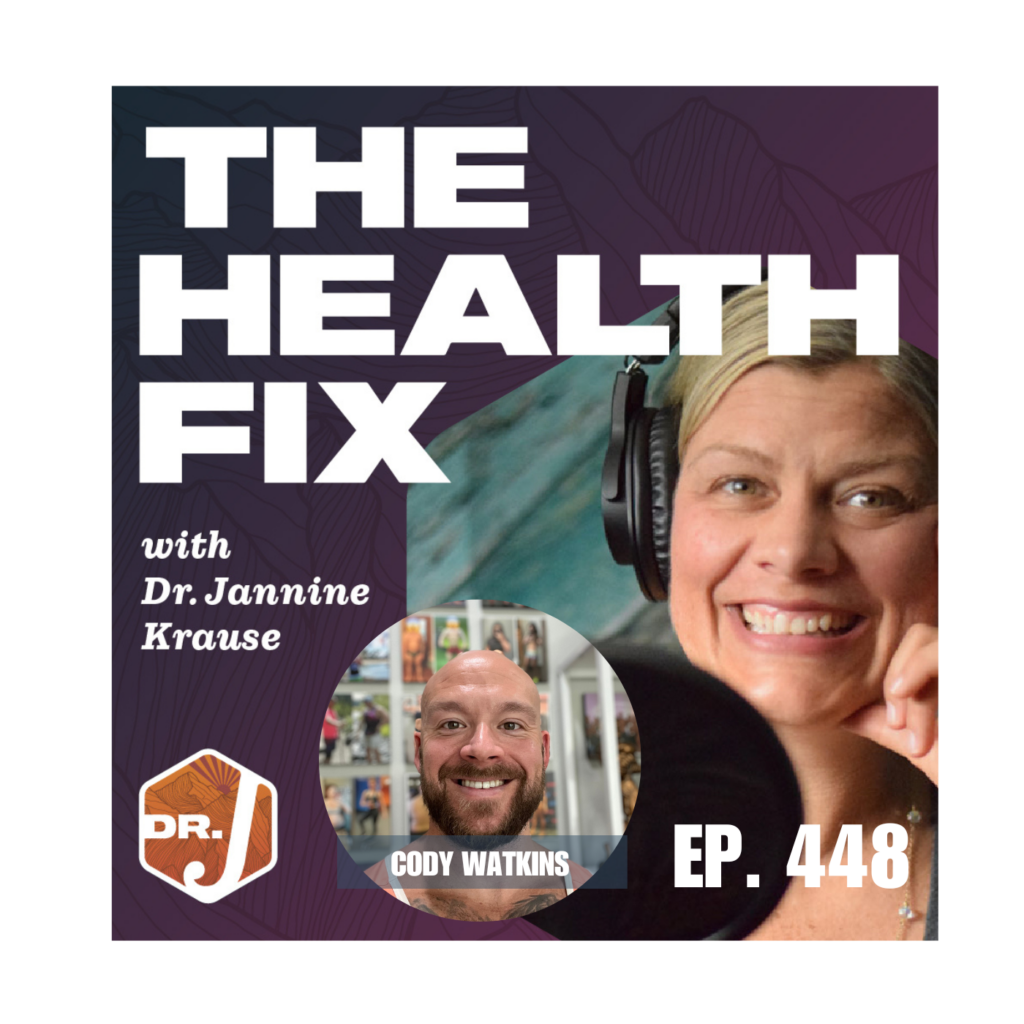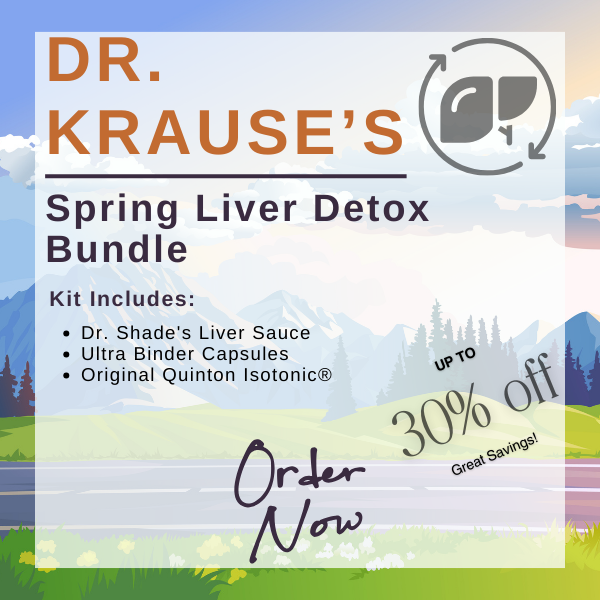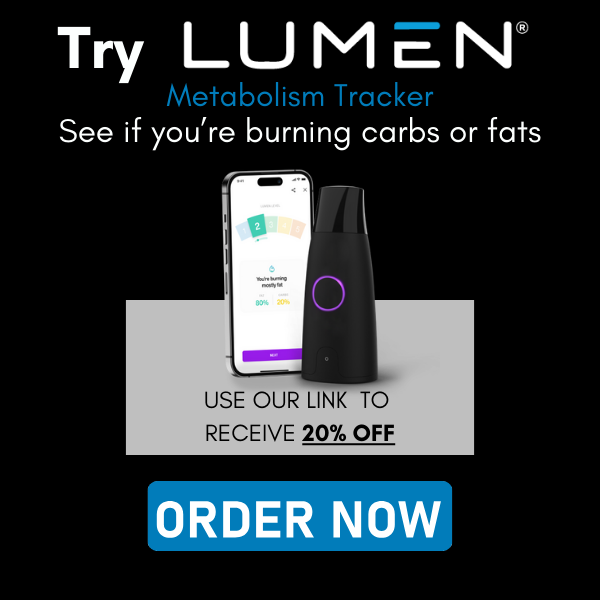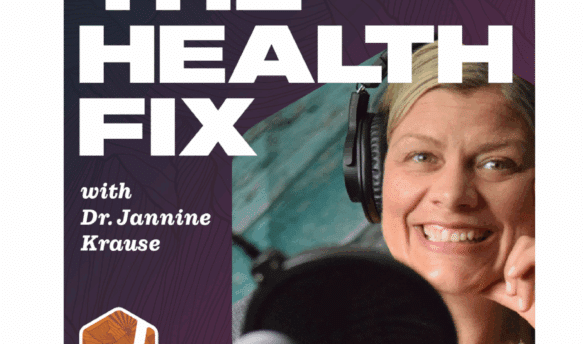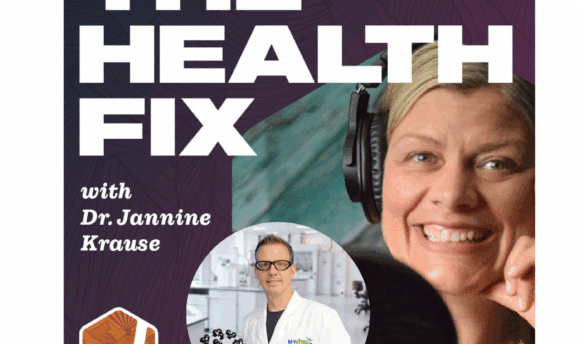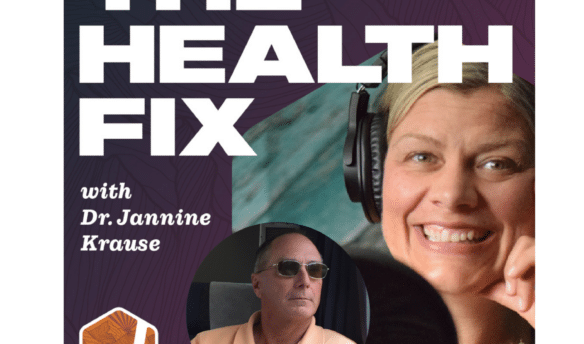Stuck at a certain weight and can’t drop weight no matter what? Feeling like you’ve hit a plateau with your weight and fitness progress. Cody Watkins was an out of shape high schooler who taught himself how to get into shape with powerlifting and bodybuilding. Even a birth defect that led him to open heart surgery and a come back 11 months after surgery at the age of 30 didn’t stop him. Seventeen years later Cody has helped over 2000 people achieve better lives through fitness by simplifying their way to success. In this 2 part series of The Health Fix Podcast, Dr. Jannine Krause interviews Cody Watkins on why he doesn’t believe in plateaus and how to reboot your metabolism to lose weight once and for all.
Dr. Krause’s Protocols
Instructions Included
Traveling soon? Looking to detox or reset your gut? Try one of Dr. Krause’s Fullscript plans.
What You’ll Learn In This Episode:
- Why Cody doesn’t believe in Plateaus
- What to do when nothing is working to lose weight
- How gastric bypass interferes with your health goals
- Soreness post workout doesn’t ensure results
- Cody’s protocol for firing up your metabolism
- Art of improving intensity over time to gain muscles
- How you can eat pizza 3x a week in maintenance mode
Resources From The Show:
- Cody Watkins Fitness on Instagram
- DM him: Coach33 if you’re interested in working with Cody
Our Partners
Podcast Transcript
4:03 – How much soreness is too much? And what may be causing excess soreness
6:37 – Plateaus
11:15 – Lack of intensity
16:09 – What do you have runners work on?
23:44 – Ozempic etc…
26:22 – Gastric bypass surgery
30:32 – Digestion
32:33 – Other things to focus on instead of the scale
39:54 – The Secret to being able to eat pizza 3x a week…
46:09 – Checking how lean you are with visuals
51:22 – The subtle approach to shedding fat
[Intro] Welcome to the Health Fix Podcast, where health junkies get their weekly
fix of tips, tools, and techniques to have limitless energy, sharp minds, and fit
physiques for life.
Hey health junkies.
On this episode of the Health Fix Podcast, I brought back Cody Watkins because we had
such a great conversation last time on health and fitness.
This round, I really wanted to pick his brain about metabolism and how he’s helped
over 2000 people achieve better lives lose fat, gain muscle and get the bodies that they dreamed
of. So in this episode, he’s going to go into some deep detail on how he’s working with clients
to get success. I learned a few things and it was so inspiring, but also fascinating that we had
a split into two podcasts. So this is part one. All right, let’s reintroduce you to Cody Watkins.
JANNINE: Hey, health junkies. I have Cody Watkins on again. And boy, are we going to talk about some stuff that I get asked about all the time. So Cody, welcome to the Health Fix Podcast again.
CODY: Thanks for having me back.
JANNINE: Man, last time we were cracking up and I’ve been cracking up on your Instagram since we talked last because every single meme you’ve got on there. Yep, understand that. Yep, understand that one. So I just want to put a big little props out to you for just keeping keeping the vibe of happy.
and hilarious on there.
CODY: Well, that’s what we go for, right?
People take fitness too serious,
and yeah, you gotta be seriously good results,
but you gotta have fun while you’re doing it.
JANNINE: You know, there is that balance, right?
Like, you can have fun being serious about your results.
I think that’s what we lose in this whole thing.
Everyone thinks we have to be like robots and eat like robots
and really just to get in there and grind
and it has to not be fun.
And that’s the same thing with medicine too.
I feel the same way.
It’s like, why can’t medicine be fun?
CODY: We should feel better, right?
The end result is feeling better.
So that’s not bad.
It shouldn’t be a bad time to do that, right?
And so if you kind of enter fitness
and it’s leaving a bad taste in your mouth,
the likelihood that you’re gonna stick
with what you’re doing ends up being very, very low
in comparison.
JANNINE: I like, you’ve probably seen this.
Like being in the industry as you are,
where people are like, there’s kind of people
want to be like, let’s put this way killed during a workout. And they’re like, they enjoy that. They’re
like, that is my jam. But there’s other people who are like, that was the worst thing ever. I,
you know, like, I don’t even know, like, it’s four days later. And I’m still sore. I can’t get out of
bed. This isn’t fun. Now, of course, like what you just said, you’re not going to come back to
it because it’s not fun. So it’s like, how, how do we find that, that happy balance and enjoy
in it. So–
CODY: You’ve got to figure out which kind of person you are too. So like with me, I’m so
result oriented. It’s not about the result of the workout, like how I feel about that. That’s just
information. It’s it is it getting me to the goal that I set out to get. So if I’m sore or not,
it doesn’t matter to me as long as I’m moving the needle toward where I’m trying to get to.
Like that’s it. But people at Chase of Soreness like, I mean, I can make anyone sore or you can
and under eat and be sore.
So I don’t always think that’s a good thing.
But likewise, you should typically feel something,
but yeah, if you’re like a trainer coaching like that
and most of your clients aren’t moving for five days,
you’re probably not gonna have a lot of,
you’re gonna have a lot of turnover.
We’ll just say that.
(laughs)
JANNINE: Well, and I mean, it’s one of the questions I get
for my patients a lot is like,
should I be sore after workout and how long should I be sore?
And when someone says like,
yeah, I’ve been sore five days, I’m like overdone.
Like, by far, what do you tell people, just in general,
what’s kind of your blanket statement
in terms of soreness to get results?
And like you just said, it sounds like you don’t even
have to be sore to get results.
So I wanna hear you kind of, your spiel on that
so folks can kind of hear your take on it.
CODY: Yeah, so soreness is, it’s a good gauge
when something’s different,
but not necessarily in terms of results.
So like if you were one of my clients,
we started a new workout regime.
Even if you were training five, six days a week,
It’s so different from what you were doing
that you’re probably gonna feel it in places you have, right?
Because it’s a new order, a new sequence.
But the thing is like maybe new with legs,
we get one to two days of soreness, maybe three.
If anything’s beyond three,
you either were undernourished,
going into the workout or you’re overtraining
or a combination bolt.
So you gotta look at those variables.
But for new people coming in,
yeah, you’re gonna feel it if it’s new.
But the next week, you should feel it a little bit less.
And in the week after, you probably won’t even be sore.
You’ll be maybe tight the next day.
but this is where you’ll watch other variables, right?
We make sure you’re increasing strength, reps, intensity of it,
whatever, uh,
measurable you’re watching.
And that’s where you’re going to gauge results.
So soreness is it’s correlated, but not directly.
It’s not linear to your progress.
So yeah, it’s nice to know you did something different,
but it does not go hand in hand when it comes to progress.
So like if you take bodybuilding, for instance,
I’ve never had my shoulder sore training.
JANNINE: Wow.
CODY: But it’s never been that they didn’t grow.
And my legs are probably like my worst body part
and they’ve been the most sore probably through everything.
So there’s some discrepancies there.
(laughs)
JANNINE: Absolutely, absolutely.
And I mean, I think about it
and I think about the over the course
of like a training block, right?
You start out, yeah, there’s usually some soreness
and like you said, as long as you’re making progress,
weight’s going up, you’re able to lift more.
You know, that’s good.
And yeah, you might not be sore.
And I do tend to find that like sometimes when it’s a new block and new exercises, the first
week I’ll film more.
And then after that, it’s like nothing.
CODY: Yeah, but if you’re getting crippled or it’s like beyond day three, like you’re either
overdoing or under eating or a combination of both.
So you got to look at your whole your program as a whole and kind of see what what variable
needs to change.
JANNINE: And this is what leads me into like one of the biggest questions I get from clients left
and right is like, I’ve hit a plateau.
working, the weight’s not coming off, like doc, what do I do? And a lot of times there’ll be some
correlation to like, I’ll ask, well, what are you doing for workouts? How you been doing?
I’ll have been crushing myself in the gym. And I’m sore, like, you know, I’m like, yeah.
So I’m going to have you kind of give us the scoop on, you know, kind of that kind of why you
don’t believe in plateaus and like what’s going on when it seems that nothing’s working. Tell us,
help us please.
CODY: Plateaus, I mean the best way to put it is a plateau is bullsh*t, right? Now not saying that
they can’t happen but where most people think they’re at a plateau they’re not watching
not variables to have a full scope of it and or they’re not watching enough inputs to know if
they even are at a plateau. So my point being a lot of people be like I’m stuck a matter of plateau,
nothing changing and they looked at the wait Monday and they looked at the wait Wednesday.
That’s fantastic. Are you actually stuck? Maybe you didn’t sleep as long on Wednesday, right? So
the wait didn’t come off. Maybe you’re up early, maybe you’re stressed, maybe you got some food
that’s loading you. So first, define that your plateau is actually a plateau. Now, if you’ve been
logging all your strength, logging all your workouts, logging all your food, you have good energy,
good rest, good recovery, and you’re sitting there for two-ish or more weeks, then yes,
you may be getting stuck, but I don’t like to think about the word plateau because it kind of defines
no hope. It means your body has simply adjusted to what you’re doing. It is adapted to what it is,
and this is metabolic adaptation, which happens. So what we now have to do is we either have to
increase the output, we have to decrease the input, but we have to change the stimulus in
its entirety. And one of those, or all three of those, will move that needle. Now, and also in
So in this context, like when you’re talking plateau, you got to make sure that you were
doing everything that you were supposed to, right?
So if you’re trying to blame like a program as a whole, maybe you aren’t being so keen
on nutrition, log on things a little sporadically, you’re probably not out of plateau.
You’re probably just deviating more than you think.
If you’re like, no, I’m crushing my workouts.
Are you?
Because if we look back and, you know, maybe say you’re going for like eight, 12 reps and
you’re getting 12 reps on everything. Is that crushing it or maybe should you try to bump that
weight up and go for eight reps, right? So maybe you didn’t push the intensity of those workouts
enough. So it’s not that maybe the workouts are broken, but maybe how you’re applying those workouts
is broken. Like with your stress, your sleep, your gut, food allergies, those things can all
factor it. But if it’s the point where it’s like two weeks and you don’t have any of that going on,
yeah, you’ve got to change your approach, right? So you’re trying to run and get across a room,
there’s something in your way, we just stop when there’s a coffee table, right? You’d either work
harder and go over it. You’d work a little longer, go around it, but you’d find a new path, right?
We don’t go, “Plateau, I’m done.” That’s it. That’s all she wrote. So then look at it like, “Okay,
could I perhaps switch my workouts up?” Maybe a different sequence. Maybe you’re only working
out two or three days a week. Maybe four or five days a week would work. Maybe the intensity of
the workouts. Maybe the rep range of the workouts. Maybe the rest time, maybe you need to do more
or super sets with those workouts.
Maybe your calories are actually a little bit too high
for your stimulus.
The most common one I see though is movement decrease.
So maybe you crank that cardio up as you went,
get an 8,000 steps a day,
but now you added 30 minutes cardio.
But you’re still getting 8,000 steps a day.
So did you do more output
or did you just exchange output from AASED walking
to elliptical?
So really what it is is your perception of your effort in
is higher than what is actually in there.
And so that’s also another variable to look at.
But two weeks is that switch mark.
Then you switch it, right?
Whether it’s intensity of the workouts,
how much food you’re in taking, or a sequence,
either they’re switching on how many days,
what you’re doing those days, et cetera.
And that’s usually enough to get the body
in its movement, right?
Now, if you’re doing all of these things
and still not getting outputs,
this could be like where you touch base with a doctor
and it’s a hormonal problem.
but I don’t blame the hormones first and foremost.
If anything, they slow things down.
They don’t stop them.
So that’s just another way to look at.
So when I hear hooves, I think a horse is not zebra’s.
So I don’t look for the complicated things first.
I like to make sure the program as this whole
isn’t working before I look much deeper
when it comes to that.
JANNINE: Yeah, yeah.
I appreciate you saying that hormones will slow things
but they won’t halt it
because it is the number one thing that people ask me
and so they think they need more hormones
or they need more of those.
They need to adjust it or detox or you name it, right?
One of the things that you said that,
that piques my interest is the intensity
because we’re constantly being told as women in particular,
too much intensity is gonna wear you out.
And if you’re already worn out, you need to back down.
And here’s the thing, I find that most women
aren’t giving enough intensity,
but that’s actually the problem.
And that’s why the metabolism slows
because we’re not doing the intensity.
So I’m going to have you kind of speak to that.
CODY: Yeah.
And I don’t think it’s just women.
We, we are in a society now that it chastises intensity.
So I remember when, you know, when I first got into lifting 15, 20 years ago, when I would go up to the gym, I would see these skinny little guys lifting way more weight than they ever should.
And you’d think, wow, he’s, you know, he’s kind of looking like a jackass.
Like this guy weighs 120.
He’s trying to curl a 50.
Like that’s bad for, but now it’s the flip side, right?
You have so many of these social media influencers and their guys.
My size are curling a 10 pound weight.
And they’re like, you just need to focus on the squeeze.
That is not going to get you your body.
I promise you that these girls that you see doing 10 pound
glute kickbacks, these guys that you see doing 10 pound
bicep curls, none of them did that to get those amazing bodies.
They have every single one of them.
Clicked the time in, lifted the weights,
did they progressively heavier?
And they’re trying to sell you a load of fluff
on what works when it’s really, it’s nothing.
it would have never worked to get them to that body in the first place. So women, a intensity,
it has to be there because you don’t have as much muscle master, you do have to put in
equal amounts of work, right? There’s no way around that you gotta push those workouts.
And the thing is from a stress portal, all that perspective, as long as the volume of your workout
is not insane in comparison, and your hormones, like you’re not at zero testosterone, you’re going
to make products, right? And you’ll see it on the flip side of biomarkers, right? Maybe if your
resting heart rate is elevating, your breathing rate tends to change a little bit. Maybe you’re
not recovering as well, but you’ll be able to evaluate that as you go. So if you’re like a 60
resting heart rate, you kick that training intensity up also, and you’re 65 to 67. Hey,
body’s probably not recovering ideal. So then it goes back to, hey, do we have proper nutrition?
It’s maybe just not the stimulus, but in this instance, women got you got to push, right? So
So if you’re doing like a eight to 12 rep range, 12 is not the goal.
And this is where I see most people go.
They go, okay, good.
I did 50 for 12, 50 for 12, 50 for 12.
Fantastic.
But that tells me, Jen, that you need to do eight.
And Jen’s like, well, but I got 12.
Well, it’s not the goal.
So what we do is when we can get to 12, we try five pounds more to get at least eight.
And then if we get eight, we go cool.
And then we try to get nine, 10, 11, 12, whatever it is.
not just that week, maybe it’s, you know, progress over time. When we get to 12, we bump it up.
And so say you get to 12 at 60, you go for 65, you only get six or seven. Cool. We know that it
wasn’t quite time to bump it up yet. So maybe we got to run that 12, you know, a little bit
half a range, like 13, 14 or 15, just so we can push enough stimulus error. And then we do the leap
frog method. Power it up and do that. We do that over time. And you’re gonna have more muscle before
you know it, you’re gonna be able to whoop somebody’s tail if they try to steal your purse, right? All
kinds of cool stuff. So, but you got to, you got to push the body, right? The body, it’s lazy.
It will do no more than it costs to. So if it’s going up there and it’s like,
ah, yeah, jams at the gym again. So let’s get ready for the 20 pounders. We’ve been doing these
for 36 weeks. Okay, cool. I noticed how to do it. So it has made that the most efficient it can.
And efficiency is a fancy word for not burning as many calories. So we want inefficiencies. We want
want the stuff that’s hard. We want the stuff that’s challenging to the
body’s one. Oh, no, I better, I better burn some calories and actually
figure this out. Likewise, I’ll back to the plateau thing. You can see it
with cardio because people will get married to a machine. And when they’re
made that machine, it becomes so efficient. They’re like, no, I’m doing
45 minutes on the stairmaster. Okay, cool. Try 45 minutes on the road.
And they’re like, Oh, dear God, I was 15 minutes in. I’m dying. Cool.
You got 30 more to go. Now we’re working, right? Or, you know,
So Jacob’s ladder or something different.
So that that particular pattern is not efficient, right?
And it can be as little as cranking up the resistance, going backwards on an elliptical
and set up forwards.
It just has to be a different biomechanic than you’re used to.
And then once you do that, now it’s like inefficiency, the first time, like everyone
here’s rode a bicycle.
First time you got on a bicycle, you could not ride in a straight line.
And now you can talk on your phone, pedal around, do all this stuff, right?
Because that pattern is in because it’s easier to do.
first time you’re probably sweating bullets just trying to drive in a straight line across your
yard.
JANNINE: Oh, it’s so true, so true. And then some days on the elliptical, I can’t see the things
connected. And I can’t seem to like get the sequence down. Yeah, no, I’m not a fan of
cardio machines. But all joking aside, I do tend to [inaudible]. Oh, man. Yeah, you know,
that’s the one thing that I think a lot of us just need to hear is that we need to switch
things up. We do need to challenge the intensity. Sometimes it is the issue. And, you know, one
big thing is a lot of runners, right? They’ll run. They’re all about mileage. And I’m like,
how about some speed up slow down? How about run some backwards? You know, what do you do with
runners that that come in and lift and work with you too?
CODY: Glutes and hamstrings. So running is,
again, when a runner is good, it’s because they made the motion efficient.
Right. It’s no other thing.
So they’re able to put in the miles
because their mechanics are so good.
But what they’ve done in the process
is create a lot of muscle imbalances.
So that’s why you won’t look at a lot of distance runners.
You’re like, wow, she’s got an amazing butt.
You’re like, well, she can run 12 miles.
Cool. But what’s weak in that chain?
And so usually they get over tight hip flexors.
The hamstrings get tight.
They overuse their quads just from the hip positioning.
So if they come in, they start strengthening hips.
They start strengthening hamstrings,
they start stretching or strengthening glutes, sorry,
stretching hips, strengthening hamstrings.
Now they’re bringing that posture back to a balance.
Plus you got to think from a strength perspective,
if you can increase the output of a muscle,
they can increase speed.
So the distance between like,
okay, maybe they’re running at whatever five miles an hour,
but if running gets easier,
they could run 5.2, 5.3, 5.4, no problem,
because now they have the actual muscle strength to do so.
So now they can cover more distance and less time
just by becoming more efficient with the actual mechanics
of what’s firing up in that motion.
They’re not fighting in imbalance.
Everything’s flowing.
JANNINE: That makes sense.
CODY: And you don’t have a flat butt.
So that’s a plus two.
JANNINE: I mean, yeah, yeah.
No, it’s definitely having the glute strength this huge.
I mean, ultimately, if we look at it,
a lot of people might be like,
well, I like my flat butt.
Well, do you like the idea of getting up off of a toilet?
because that is the thing as we get older,
is we need to be thinking, right?
Like, how can I keep myself out of the system living?
How can I keep myself in my house longer?
Flat butts won’t get you there.
CODY: Gotta have the glute strength, get you off the floor.
JANNINE: There you go.
Yeah, I don’t wanna be pressing that button.
I’ve fallen and I can’t get up that.
(laughing)
CODY: The life alert, with the pendant.
(laughing)
JANNINE: I do not want to–
CODY: There’s a, I forget the city over in Japan,
but it has an average of,
highest average of 100 plus year olds living there. But if you look at the Japanese culture,
they don’t use chairs. They don’t sit. And like, they don’t have traditional toilets. It’s
literally a hole in the floor. So this 100 plus year old person that would not be able to not be
an assisted living here in the United States, they’re moving themselves up and down all day
because they’ve done that their entire life. So they sit down, they got to get up completely
out the floor, they have to go to the bathroom, they have to do a full squat, heels to glutes,
right? All day. And so it’s that same user to lose it. So, you know, if anyone knows anyone that’s
retired, you will see this every time. If they retire and don’t do anything, they age 10 times as
quick as someone who stays doing something. That’s why you’ll see a lot of successful people
retire and then go back to work, not because they need the money, but because they can feel
themselves slipping away from a purpose, a goal and all that. And they just begin to age rather
rapidly in that situation.
JANNINE: Yeah.
No, I’ve seen it over and over again.
Even my patients now that I’ve been in one place long enough to see the
trajectory of someone, it’s just like, Oh my gosh.
Yeah, it just speeds up.
So I’m kind of like, I don’t think I’m ever retiring.
It’s just
CODY: No, you just got to choose your future.
Stress free patients at that time, you know.
JANNINE: You know it, you know it.
So let’s talk about, let’s talk about this concept.
like that you get to a plateau, we already talked about that.
You, we fit in why you don’t believe in it, how you got those two weeks and
you’re things out.
And then we’ve got a lot of folks who’ll just be like, screw it.
I’m going for like gastric bypass or screw it.
I’m going to get the semaglutide out and I’m going to, I’m going to start
that and see if that can help me.
What’s, what’s kind of your statement there when, when we, or what can happen
when someone does those sorts of things?
I know that semaglutide and gastric bypass are very different, but I’ll
let you kind of take it from there.
CODY: So you got to think it’s changing the perspective.
And we have a very short-sighted goal perspective
here in the United States.
So I want it now in sync gratitude, all that.
And the problem is it usually isn’t the right choice.
And I’ll paraphrase a story.
It’ll make a bit more sense.
But let’s say your neighbor is out
like watering the dirt, planting a plant,
and all of a sudden it’s growing.
And you’re like, well, there’s such a good gardener.
And then your other neighbor across the street
is planting, watering dirt.
And he’s doing it for three years.
And you’re like, John, what are you doing?
Like, I’m watering my Chinese bamboo tree.
And you’re like, John, you’ve been watering dirt
for three years, buddy.
Cindy over here’s already got like a six foot pear tree.
You’re like, what are you doing, man?
I’m watering my Chinese bamboo tree.
I’m like, that’s dirt.
What are you doing?
But what people can’t see is the whole time
that thing has grown roots.
And once it finally breaks the surface,
the X amount of years later, it grows like six to 90 feet a day.
So even though you look at Cindy’s
and you’re like, “Well, she’s making great progress.”
On the short term,
it’s not the long-term progress that you would see.
And so it’s a band-aid over a stitch-roomed.
And so for some people like you said,
“Okay, if you’re six, seven hundred pounds,
you can’t stop eating.”
Okay, it’s time to button that stomach up
because that’s your only option, right?
Because you’re basically gonna die if you don’t do this.
Now, in the peptide situation,
the semi-glutides, ozempics, all these things.
And the gas reply pass, these are crutches.
And so what these are is unfortunately,
I think there’s a bit of a money drive to it
because doctors will make money prescribing things,
surgeries and all that.
99% of the people that get them,
I do not think need them.
Also, if you’re on the flip side, if you sit where I do,
you’re gonna see how many people get the wicked backlash
from it.
The 30, 40% of people that get these done
that rebound the weight that they put on,
even after gastric bypass, even after ozempic, even after all this stuff, because what you never did
was you never fix the problem. So if your problem was cocaine and you’re, you’ve got
locked in a rehab center, well, there’s no cocaine that you have access to. So of course,
you’re sober. But then we put you right back in your house and you lived with your drug dealer.
Do you think you still quit cocaine? Probably not. And this is why alcoholics
anonymous have a 90% failure rate. This is why rehab institutions have 90 plus percent failure
rate because no one ever changes the environment. And so the problem is ozempic, gaseous rycos,
you never change the environment. You never told them that eating McDonald’s was bad.
You told them, “Cool, we’re just going to eat less McDonald’s,” which will work
from a weight loss perspective, but it will not work from a health and a body composition
perspective because simply put, you’re just eating less garbage because you can’t physically fit it.
So the minute you stretch your stomach out or you come off of Ozempic , guess what happens?
That weight comes flying back up. Now the problem is because of what you’ve done,
you literally have to work it off because there’s no way at this point you can train your metabolism
to get better other than adding muscle and your ability to consume calories is so minimal.
You’re going to have to work three, four, five times as far as you ever would have
simply doing it the right path in the first place.
JANNINE: So hard and it’s so hard to convince someone of that. Especially now with the
ozempic and how it’s been put out there. Unfortunately, what I’m seeing and I don’t know if you’ve seen
seeing this too, some folks that are trying to lean out a little bit more, 20 maybe 30 pounds to lose
are trying to get into those injections as well. Have you seen that in your
CODY: Oh, I’m crossing board, cross the board.
And it’s, it’s awful.
So like it’s getting prescribed for anyone that’s coming in there.
Like, oh, I can’t lose weight.
So I’m focusing on anything like, Hey, have you tried eating more protein?
Or hey, how do you try exercising?
They go, Oh, well here, try this drug.
And that’s like the fourth thing down on the sequence, right?
Like you check the nutrition, you check the training, you check the activity,
you check the hormones.
And then if all those are in check, we go, okay, the body’s probably a little stubborn,
maybe we need a little extra help. And that’s when you would potentially look at stuff like this.
So even though the mechanisms itself, it’s a, and I’m going to butcher the word here,
Graylin, I believe is how pronounce it, the hormone.
Ghreline, Ghreline.
CODY: Ghreline. Yes, that one. So Dr. Speak, I just read them all though, right? So with this,
that is your hormone that tells you to eat. So, ozempic suppresses this. So, you’re suppressing
appetite and it slows gastric release. This is also where a lot of its side effects come in. But
just from a basic, it slows gastric release. So, in a nutshell, your basic person could mimic
these results by drinking apple cider vinegar with their meals and eating 25 to 30 grams of protein
for me. And I guarantee you would dump more weight than
ozempic doing that because simply put that’s way to give
you the same output outputs with a muscle preserving tendency,
because now you have enough protein to actually keep them
muscle. So you’re not going to look like this saggy,
deflated skin person, because if you know anyone that’s
on ozempic, they look gaunt, they look like they’re starving,
they’re malnourished. And so they drop weight, but there’s
you never muscle tone or definition.
And I don’t know a single person,
even if they tell me they want weight loss,
that actually means weight loss.
They all mean fat loss.
And so nothing in those preserves it.
So the problem with Ozempic is because you don’t learn
how much you don’t learn in the lifestyles,
you are going to gain the weight back
with the avengence when you’re out.
So if you look at even the clinical data they have,
there’s a 90% weight gain rate, one stop, one stop.
So only 10% of the people actually lose weight on it
are going to keep that weight off.
And I would imagine that’s an over inflated,
that’s probably just a 10% that didn’t check back in
with them, but off the data,
90% of people gain it back when you come off.
So ask yourself, do you wanna be on that for the rest of your life?
If the answer is no, it’s probably needed a different plan.
Now, gastric bypass is much,
much, much, much worse in my opinion.
Now I’m not an Ozempic fan,
but this one is permanent.
JANNINE: Yeah.
And the problem with this one,
I’m sure you’ve seen it too,
but I’ve had people that get gastric bypass.
They’ll dump 50, 100 pounds, 200 pounds, cool.
And all of a sudden it goes, funk stops,
hangs out maybe two, three months, maybe a year,
and then it starts going.
Now the funny thing is, these people can’t actually eat.
So now even when they’re eating,
they’re stuffing their face and eating, you know,
15, 1700 calories, right?
And extreme discomfort,
because how much they’re pushing that stomach capacity,
But what happens is you lose weight
essentially off the third principle.
So because you’re dropping it so fast,
it’s never a body fat.
It’s a third fat, third water, third muscle.
So I had a gal super, super sweet.
I’ll leave her name out of this,
but she was a client originally,
10 plus years ago doing tire flips,
super strong running marathons.
She was a bigger gal who had gained weight over the years,
so she got frustrated and I’m doing gastric bypass anyways,
drops back down to under 200
where we’ve had her pretty close to before, right?
I’m not gonna, you know, shun somebody for it, right?
Whats done is done, we’ll just find the best path forward.
So anyways, I get her back up in the gym.
This was when I was in in person.
And again, this is a guy who’s flipping tires,
leg pressing 600 pounds, like all this stuff,
while losing weight.
And she can’t even do 90 pounds,
we’ll both feet on the cable [inaudible].
She had lost so much muscle in that process.
And the thing is, the calorie intake,
she can’t gain it back.
She doesn’t have the ability to eat enough protein
on top of everything else to actually gain anywhere
near the muscles she has.
So that muscles your metabolism, guys.
So you strip that muscle off over time
and your metabolism’s going slower and slower and slower.
So that’s why initially from like,
gosh, right fast, you’re like, wow, 50 pounds off.
30, 20, 10.
And it slows down because every pound of muscle
you’re losing, it’s less and less burn.
And so the body not only adapts to the new calories,
’cause you gotta think, like, if the body didn’t adapt,
it would just die when you did a gap to ripen.
It’s just going, oh, well, no, no, no,
if I’m gonna starve to death.
So it goes, ooh, not getting my 3000 no more, I think,
okay, I gotta learn how to live with 1000.
Let’s see how we do this.
And so it does, it’s like a tortured prisoner.
And so the thing is, it’s gonna do anything
it can to survive prisoners don’t look good, right?
They’re not high functioning, but they’re alive, right?
And that’s essentially what your body is about,
it’s just functioning.
It’s doing the basic it needs to to get things done.
So if you look, your output probably goes down, your step counts probably through the floor,
you have no energy, you’re not moving around very well.
You initially feel better, you have a little more happiness up because you’re lighter,
but you’ve lost so much muscle, but the longevity of it is not there.
And so the downside is the only way to build a metabolism is to increase the intake of
food.
But how do you increase intake when you don’t have capacity?
Very, very challenging to do.
And likewise, they’re so paranoid about gaining weight.
That’s why they got the surgery.
They don’t want to see it even tick up.
And so if you have to be able to like a bow and arrow, right, we got to build a pull it back.
So we get some momentum forward and that scale may have to go up for a little bit while you
actually get that metabolism a little bit of a breather and attempt to get it burning.
So you can actually finish out the fat loss and most importantly, finish trying to gain
some muscle back so you can actually have muscle definition and muscle tone before that scale
starts creeping back up for your from your extremely impaired metabolism.
JANNINE: Yeah.
Oh, it’s so hard.
It’s so hard.
And I mean, even just kind of the same trajectory, independent of gastric bypass, I feel like
a lot of women kind of put themselves on a gastric bypass diet anyway, you know, without
the surgery because they’ll start taking down their calories.
And it’s so common.
I’m sure you’ve probably seen this too.
A lot of women just seem to not want protein as they get older.
And I know it has a lot to do with digestion myself included.
I’ve had some issues over the years.
I see that being like such a issue.
CODY: Well, when you’re talking digestion too, it’s not uncommon because doctors over prescribed
an acids and acid is what breaks down the protein.
So you mix the pack where over prescribed those, we get decrease in stomach acidity with age,
which leads to permeable guts, leaky guts, all this stuff.
So you know, if you’re over 30, there’s a high chance you probably need to be taking
some like B-Tane HCl plus pepsin with like lunch and dinner or one of those meals is heavier protein
because if you notice that protein is that heavy it probably just is the acidity or stomachs too low
to digest it and so if we can crank the acidity up on that all of a sudden the protein as it said
is heavy you’ll be full but not like you ate a brick and so now we’ll get better utilization
better better all that out of it and once we do that we’re good to go. JANNINE: Yeah yeah so I mean that
And that was a game changer for me, because I got to a point like the same thing, like
the protein just sitting and I’m like, oh, and I see it happen like as a slow thing to
a lot of women where they’re not really realizing like it’s digestion.
They’re just like, no, I feel like I just want more carbs lately.
Or you know, when it’s like, it’s because your body’s like, I need to eat something.
CODY: And carbs don’t take like they don’t take the acidity to break them.
That’s why you can just eat them and you feel great.
You know, proteins and even fats take quite a bit more as far as digestive work that to
actually use. And so yeah, in that point right there, if you do notice yourself
gravitating more towards carbs, maybe you need to look at how can I increase the
acidity levels in my stomach to help digest this food? And then you can start
shifting those gears really getting that composition you’re looking for.
JANNINE: Huge, huge point. How long have you seen on average when someone shifts their
diet to start eating more protein to, and like you said, you might see the weight
go up at first. How long on average do you see it take to kind of shift it to get the
metabolism back fired up? Because I see all kinds of things online in terms of what is
real, but I’d like to hear from like, what have you seen over time?
CODY: It’s honestly usually really, really quick. Now, if you’re someone who had a lot of the
inputs correct at first, like, okay, you’re training in five days a week, eating, you
know, whatever, 80 to 100 grams of protein, it’s not going to be quite as drastic. But
Basically, when I bring someone on, especially from a female perspective,
most of them are not training or training near as intense as they should.
So we get this initial pick up and muscle, but the fat loss should still be going
down if the diet is composed.
So with that, the muscle gain is usually faster than the fat loss.
So what happens is we’ll pick up on the scale two, four, maybe six weeks maximum.
But this is why having multiple things to watch when it comes to your
if Atlas is key, because if we only watch the scale,
your goal is not to look good on scale.
Like you’re thinking, you went on a date,
no one’s ever been like, hey,
I think you look amazing, but please step on this.
So I’ll tell you, right?
Never has that happened.
So they look at you go, damn,
or maybe there’s room for improvement, right?
So from a visual, we’re the only ones that care about the scale.
So when you take it out of context, right?
Let’s say you started out,
you were 150 on Monday, you started your program,
You’re 152 at the end of the week.
Most girls would be like, “Ah, this plan isn’t working.
Ah, what do I do?”
Well, I like to think of, that’s two of these, a water, right?
I wouldn’t panic if I drank too glass of water
and got a lot of scale.
Well, okay, yeah, check.
We got more water on the muscles.
They’re 80% fluid, that’s bound.
But this is where you can get kind of a point of reference.
Pictures are good for coaches
because we have a different discrepancy with it, right?
You’re emotionally attached to you.
So you’re going to nitpick them apart and you’re probably not going to see it
till it’s a very drastic change.
Now, one thing you can’t nite in the driver seat is tape measures.
Okay.
So if you start out in your waist is whatever, 35 inches and end of the week,
it’s 34 and a half.
I do not care if you’re up five pounds.
We’re trending the right way.
Everything’s going down.
Perfect.
So what’ll happen is cool.
I’ve gained muscle, which is going to help me for the long term and I’m losing
fat.
I’m going to ride this up because at the end of the day, we’re not chasing scale,
right?
We’re facing a look.
And if we get that look there, perfect.
So make sure you have your other measables.
I measure the waist of the belly button,
the waist of the small part, and the biggest area of the glutes.
Those are the three.
You can measure arms, legs, hips, all that other stuff.
But those three are the ones that are going to tell the story.
Take pictures, right?
But do it every two, two, three weeks, right?
Any sooner in that, it’s going to look the same.
Make sure you have the same lighting, same place,
same location.
Don’t change anything when it comes to that.
You’ve got to have consistent variables.
And then the scale, make sure you’re weighing it
consistent times.
Don’t weigh a night.
It’s going to fluctuate too much, get it bursting in the morning,
wake up after you use a restroom.
Cool, right?
And pick two days a week, Monday, Friday, Monday, Thursday,
Monday, Saturday, doesn’t matter.
Can pair Mondays to Mondays?
Can pair Fridays to Fridays.
I like Mondays and Fridays because normally people are good
Monday through Friday, then the weekend comes to get a little
looser, right?
And then they get on the scale and they’re like, time up from
Friday.
But maybe it’s down a half a pound from the previous Monday.
So is it really up?
know when we look at the right data, right?
So then when we compare Friday,
if I was not half bound here,
I should be down at least half upon my Friday.
If I’m not, okay, maybe the measurements are on point.
Cool.
If both of those are the same at,
any time to pump the gas yet,
maybe I’m gonna write this out other week,
make sure I’m completely consistent.
You know, I didn’t grab an extra couple snacks at work.
I got all my steps in, et cetera.
And if it’s been two weeks ago,
I go, “Ah, okay, maybe I need to button up the food a little bit.
“Maybe I need to push intensity on the training.
Maybe I need to crack my stuff down a little bit,
then you can sort of play in with the variables.
JANNINE: Mm-hmm, mm-hmm.
Makes perfect sense.
Makes perfect sense.
[Advertisement] Jake and Steph from Troop Functional Mushrooms
have given you a little gift for listening to this podcast.
If you enter HealthFix20, you can get 20% off
your order of Troop Functional Mushrooms.
All right, let’s get back to the podcast.
JANNINE: So much, so much to think about,
which is why I do recommend having a coach
’cause I think it just helps streamline everything
for everyone ’cause even myself,
yeah, I’ve been doing this for a long time,
but I feel like there are things where you miss, right?
You miss certain components of things.
CODY: Yeah, well, you’re two in the weeds with it, right?
So you go, like with your client stuff, you’ll go,
I don’t know, my client, Jan,
what, this is what she needs.
And then it’s the same thing for you.
And you’re like, “Oh, but should I do 32 carbs instead of 30?
Is it 40 protein or is it 37?
Like, oh, I do it.
And it’s just overthinking, right?
‘Cause none of that’s gonna matter.
And you would never do it within your clients.
You’re like, this is what she needs, cool.
But when there’s an emotional component,
very few people can step out of that
and do their own stuff.
Like I did bodybuilding stuff,
I trained myself for 12 years in it,
but I can count on one hand how many other coaches
that I knew that did that.
Because even though they could get people
in an amazing shape,
they still had to hire someone to get themselves in shape
because they couldn’t take that emotional component out of it
to put together a logic-based plan.
JANNINE: Yeah, yeah, no, it’s all over, I think anything.
Like, God.
So no, it makes sense, it makes sense.
And it’s something I wanted folks to hear
because sometimes we’ll just be like,
I could do it myself.
Yeah, you could, but are you doing it right now?
CODY: Yeah, well, and the other thing on that too,
like you could, but what you’re gonna get, it’s the time.
So you’re either gonna pay it with some money
or you’re gonna pay it with some time.
So any one of us has been doing this with mass amounts of time in.
We have a couple of variables.
When we work with people, we get even more accelerated information.
So it’s not just me over the last 20 years.
It’s me plus 40, 50, 60 clients a month for years.
So when you combine that amount of knowledge, yes, I cannot tell you what having a period
feels like shocker.
However, I have had so many clients that have a period,
I’m very familiar with what it does to the scale,
the bloat, the cravings, and all of the above.
And so that’s the beauty of having a coach
because any woman’s put the time in,
they’ve probably worked with someone
in a very similar situation to where you’re at
where you can just put that on hyper speed
when it comes to results,
rather than having to go out and do the learning curve
where, yeah, like we’re saying,
you can try this stuff out for two weeks, make adjustments.
But man, if you could just get it right off the gate,
imagine how much quicker you could reach your end goal.
JANNINE: Mm-hmm, mm-hmm.
– Huge, huge.
So speaking about reaching end goals
and the whole concept of folks thinking,
I can never eat this again, I can never eat that again.
And you had mentioned, you know,
you can still eat pizza three times a week
and keep your luck.
And then, and when we first talked,
you had talked about even just going to Costco
and like mixing things up and being able to still
even go through the drive-through.
And this is what intrigued me about you
because a lot of folks are gonna be very pure and be like,
“No, you can only eat organic and closest to nature.”
And of course that helps, but I love pizza.
CODY: And it doesn’t grow out of the ground.
JANNINE: Right, right.
And unfortunately, yeah, I mean,
we have to think about these things.
So tell us how you can get away with eating pizza
three times a week and keep up your look
’cause I’d really like to know.
CODY: So step one, all of this is dependent on being leaner.
So you have to get lean first.
Higher body fat bodies do not cooperate.
There’s a wicked spillover.
They don’t utilize nutrients as well.
It’s just an assortment of problems.
So you do gotta put your time in.
So I’ll preface with that, right?
You can’t just start out like,
I’m 35% body fat.
Cool, three pizzas a week.
You’re not to that point, but get there
and then you open up the ticket to freedom home
because maintenance is remarkably easier than getting them.
And so what you wanna do is focus on leaning down first
since the lean bodies are up to them.
As once you get there, you know,
like midsection looks good for ladies more flat,
for guys you want some visible abs,
that’s a good benchmark for like,
cool, I’m probably lean enough to make this happen.
Then what you wanna do is try to build your metabolism
up over time.
But here’s the thing,
as you start to put on more muscle,
muscle burns calories.
And this is where it comes in.
So you can put on that extra muscle,
you burning a boatload of calories.
So when I would do bodybuilding shows,
I remember I would be backstage at the show.
And the other bodybuilding got their chicken and rice
backstage, right?
They’re eating this.
So I can’t wait to get done with the show.
And I’m going to go eat XYZ.
And this is why you’ll see a lot of those guys
if you’re in the fitness industry.
Man, I look so good after the show.
Shocker.
Because you ate the food you should’ve before the show,
after the show.
And so what I would do those a little different,
I would wait until I was depleted, which you’ll
biomarkers for that, right? A little bit in the weeds, but basically like when your glycogen levels
are stored, cards are now workouts at the flat wall. So you have ATP CP glycolic aerobic. So we’ll
throw a robot out. It’s irrelevant for training, right? So we have ATP CP, you have to do anything
triphosphate, creatine phosphate phase one, think roughly six repetitions, then glycolic carb phase,
okay, eight, 12, maybe up to 15, maybe 20, and then it goes into a road. Right. So for strength
training we focus on the first two. We can’t be in this first phase or out of this first phase
into the second unless we have carbohydrates in. So if you’re on keto, carnivore, any of that stuff,
this phase actually does not apply to you because you don’t have anything in reserve
unless you’re eating enough protein to go into glucose, right? So again, a little bit of the
wheat here, but going into it, because if we can read when we are trying to switch that phase and
that takes empty, you know when your body needs food. And if you know when your body needs food,
you can load it with the right time in excessive amounts and have that food be beneficial. So
you like pizza, right? Okay, but if you like pizza and it actually sped up your fat loss
and increased your muscle gain, how much more would you like it? JANNINE: I would love it.
CODY: And that is
where we get this, because if we can write you out to your depleted, your average person is going
going to hold 300 to 400 grams of glycogen store carbohydrates. These hold
4 grams of water per molecule. So basically in a nutshell, if you have 400, you have
1600 grams of water to that, you have 2000 grams to 454 grams in pound. You have
4 to 5 grams of glycogen water over your whole body. So even if the scale goes up from being full,
it’s not fat. It looks better. So basically if you were tracking your strength, what you’d
want to do is you wait till you’re at a point of depletion. So it looked like, you know,
you know, if you’re on the bench pressure, like five, six,
and it’s just done.
You’re like, well, what the hell?
Like it was going so good.
And then everything in that workout does the same thing.
Because again, ATPCP, you still have creatine phosphate,
you still have this short duration.
But when that runs out,
it’s like those old school trucks with a diesel tank.
If you go to go to tank two and there’s nothing in it,
the carb tank’s empty.
So you’re like, ooh.
And so you read that workout and if that whole workout’s
going like that, going like just dog crap, cool.
It’s time to eat.
Now here’s the thing, your body is going to prioritize
showing glucose into muscles before it prioritizes
burning or storing fat for fuel.
So all this food you need after the window
has a very low likelihood to go to store body fat,
and a very high likelihood to go in the muscle tissue
when you do this correctly.
So like someone like you, if you got depleted,
say you were dieting like 1500 calories,
I would tell you to go out and eat three to 4,000 calories.
And you’d be like, dude, I’m dying.
No, no, no, I’m like, cool.
And if you do it right, what happens the next day,
you’re actually lighter.
And you’re like, what dude?
How did I eat pizza and ice cream and I’m lighter?
Like cool, best case scenario, right?
You’re lighter.
Second best case scenario, you’re the same.
Expected, I would expect you to be up just
so we have weight in your gut that hasn’t digested yet.
So what you’ll do is by day two or three,
you’ll probably identical to the weight
that you were on your depletion again.
And this tells us we’re on pace, right?
So when you do this, you can actually stoke
fat loss, stoke the fire, build that up. And now you’re getting your favorite foods in
far excess of what we thought you’d do while you diet.
Flipside when it goes to maintenance is kind of the same thing. So when you notice that
tanks start to run out because it will, right, you’re not in a surplus. You do the same principle,
but at this point, you’ve increased those calories so much that you actually need to get more calories
from something so you don’t start stripping muscle. So okay, maybe we got you out your burn in 2,500,
or 3,000 calories a day.
You get behind, you get busy at work,
you’re at like 1,500 and it’s six o’clock at night.
What do you do?
You have a protein shake go to bed.
No, dude, you need 2,000 calories.
That’s three quarters of a large pizza.
So you need to actually go eat that pizza
just to check the numbers we need
to maintain the muscle mass that you have.
And it doesn’t care if it’s chicken, rice, broccoli,
any of that, it’s a number game, right?
And so this is how you do it.
So if you can use that strategy when you’re lean,
It gives you kind of some short-term stuff in the middle.
And then when you lose it, use it when you’re going
through that building phase and going into maintenance.
That’s where you can just juggle calories more fit
because you blast that metabolism up so high,
you have a lot more leeway to do so.
JANNINE: Wow.
That’s cool.
I think for a lot of people right now,
they might be thinking like, all right, Cody.
So how does this look in terms of a training block
and how does it look?
‘Cause obviously we’ve got to get lean first.
And when you say lean, you know, like, I think for body fat
percentage, a lot of folks will be thinking, are we going body fat
percentage? Are we looking at what are we looking at?
CODY: Yeah. So body fat percentage would be good. I prefer the visuals
though. So if you’re a male, you have visible apps, you’re most
likely between like 10 and 13%. Okay. That’s a good word.
It goes by the leaner, you can get the more muscle we can
even, right? But that’s a good person is should do it for ladies a flat stomach. So usually like 16 to 20,
depending on how you hold it. Because also with ladies, you’re not going to blast as quick like
you’re not like, I want to put on 30 pounds of muscle this year, you’re like, if I see that scale
go up 30 pounds, I’m going to lose it. So like, it’s a little bit more gradual. And so what we want to
do when we’re on the up once we get lean is is play it like, like building a campfire, right? So
So when you’re building the campfire, what do you do?
You don’t grab all the wood and come over and go,
boom, and snuff it out, right?
And that’s what it would be like
where people take these drastic swings up in calories.
It’s too much.
The body can only store at that point.
Pound of muscles, roughly 600 calories,
pound of fats, 3,500.
It does not take a lot to put on more muscle.
So we have to play it a little bit more strategically.
So let’s just take numbers, for instance, right?
Okay, cool.
You’re down to like 16, 18% looking good.
1500 calories, you’re like,
Cody, I want to crank my metabolism.
What do we do?
Okay, cool.
Step one, are you comfortable with the amount of cardio you’re doing right now?
And if you’re like, dude, I hate, I hate how much I have to do.
Cool.
So what we’re going to do, you’re in an hour a day.
Cool.
Let’s take 20 minutes off that this first week and let’s add 100 more calories.
You’re like, I mean, that’s not that much.
Yep.
Absolutely.
It’s not that much.
Cool.
You know, but I want to go.
Yeah.
We’ll talk to you in six months.
Okay.
So cool.
increased
our calories and we’ve decreased our output giving us roughly 150 ish calories a week.
That’s usually the number I like to play for a slower duration, right?
So what you do is you weigh Friday, or Monday Friday, weigh the next week.
Also the next week you’re like, dude, I weigh 150 again on the button.
Cool, worked.
Now let’s do it again.
So let’s maybe shave 10, 15, 20 more minutes off the treadmill.
Let’s add another 100 calories in, see what happens.
Cool, weight ticked up a little bit.
That’s what it should do.
We’re up 0.2, 0.3, 0.4, cool.
We’re gonna ride that out.
So then when the week starts to stall for a week or two,
or it goes down when you’re trying to increase,
that’s your cue.
When it goes down, I’m gonna eat a cheat meal,
and then I’m gonna restart the cycle, right?
Go up another 100, decrease cardio.
If your cardio’s like, cool, I love the amount I’m doing,
cool, stop decreasing cardio,
go up 100 to 150 calories a week.
Play that Monday Friday.
If you’re consistent, cool, it’s the same.
Cool, your maintenance.
If you like the calories you’re at, don’t change anything.
If you’re like, I wanna try to push it, cool.
They’re all another hundred, 150.
Stay the same goes up, cool, right?
And you write it like that.
So it’s a process, right?
It’s a little bit of interest to see you to watch it.
And then this is where you track with waist
and progress pictures.
So I’ve done this with hundreds of people, right?
And you usually have to talk them off a cliff
’cause of the girl, she’s like,
oh my God, I look so amazing that she gets on the scale.
And she’s like, oh my God, I’m so fat now.
And she was looking amazing three minutes before.
But here’s the thing.
I’ve had girls that I put on 30 pounds on their frame, okay?
30 and their waist is the same as where it started.
Now I ask you this, how fat can you be
when your waist is the same as you started?
Like not saying they didn’t see you on some fat,
but like some fat in the right places,
look you’re really good when it’s there, right?
So the fact that they’re not Buddha-bellying out,
like that is the perfect situation.
So when you’re going off likewise,
you wanna track the same things you track
you’re going down, you track your measurements, you track your weight, and you track with pictures.
When you’re going up, you will not see progress in the pictures. And you’re like, what do you mean?
That’s why I’m taking progress pictures. Progress pictures when you’re going up, your goal is to
look the same. And you’re like, well, that’s dumb. There’s no perception, right? So if you have like
your little chihuahua sitting next to you, you could see if you’re bigger. But by yourself,
it’s isolated. There’s nothing to compare it to. So if you’re growing that body equally,
How are you going to look any different if you’re keeping the body fat relatively the same?
You’re not. And so you’re just going to see that I weigh 10 pounds more and I look the same.
I weigh 10 pounds more and I look the same. That’s good because it means your body fat visually
hasn’t went up that much. Now, if you went up 10 pounds and you look like you have a belly,
maybe your approach was off. Maybe you did it too soon. Maybe you’re too aggressive with it.
Maybe something’s off hormonally, right, where you can’t put on muscle that quick. Something was
off on it, but it may be time to rethink your approach and or if you weren’t
lean enough get that or you’re dieting down towards where it’s actually important. But those
would be the metrics I watch with it and you want to track this stuff weekly
because this stuff is subtle right you won’t see it over time of what you’re
gonna see is when you zoom out you’re like oh my god I have made progress
that’s amazing and when you can do it like that that is the secret to success.
JANNINE: Mm-hmm. No that’s huge that’s huge that’s great for folks to hear that and
And obviously everyone has a different timeframe in which the,
the, they’ll get to that, but it does seem like it’s possible to get a lot
leaner within six to eight weeks. If not,
CODY: Well, and it’s a numbers game too, right? So if you’re a lady and you’re at like
25% body fat at 150,
you got to lose 7% body fat to get roughly in that range.
So that’s 10 and a half pounds of fat. So I mean, you get down to 139 and a half.
don’t lose any muscle, check you’re there.
One pound a week, 10 weeks, right?
That’s pretty easy.
And so when you break it down, it’s not as bad.
So when we look at like 10 pounds ago, we’re like, oh, my God,
I have to lose some pounds.
We were like, can you lose one this route, Jan?
And she’s like, yeah, what about you Cindy?
Can you lose one?
Yeah, definitely can you lose one?
Can you lose ten?
Oh, no, ten is too much.
I can’t lose that so hard.
Okay.
Cool.
Well, let’s take it one at a time.
And before you know it, you’re down 10.
And then we’re out of goal, right?
And that’s how it’s done.
But it’s the subtleties, right?
So where I think most people make the biggest mistake trying to do this is because their
approach is too drastic and too extreme.
So what happens is they get done, they have such a bad taste in their mouth about
dieting right there.
They’re on carnivore keto.
They’ve avoided every form of carbohydrate.
They’re on vegan.
They’ve avoided every form of meat.
They’re on XYZ, right?
They’ve avoided so much when they get done, they go, check.
I beat fitness.
I’m having everything I didn’t have.
So it goes.
Because here’s the thing guys, when you try to throw in just a hundred calories more a day, it’s not a lot.
And so it’s like just to put in context, that’s like you had one tablespoon of peanut butter more week.
You’re not going to be full. You’re not going to be like, Oh my God, my appetite is quench. No, you’re going to be hungry. And then you start putting more food in your body’s going oh.
She’s feeding us.
Okay, let’s get a little bit more.
And it’s going to try for it.
So you got to keep really good mental fortitude
while you go through this process.
And then I always recommend getting to a point
where A you love how the body looks and feels,
but also where you hate your food intake.
And you’re like, whoa, hang on, wait,
hate your food intake.
I want people eating so much food.
They’re like, Cody, please do not bone my food up again.
Because when they say that,
I know they will never get fat again.
Because they literally cannot eat enough
to gain the body fat.
And this is when I know I’m going to have a long-term success with a client,
because they would have to go off the deep end to undo what we did during the
process.
JANNINE: That’s incredible.
And, and that’s something that I think a lot of people don’t get to ever,
unless they’ve had a plan laid out like that.
CODY: Yeah.
And it’s, I mean, it’s, it’s a process, right?
So like you got to go to see where you’re going, but you,
you almost have to have somebody see it for you because we don’t tend to believe
in ourselves enough to actually get there.
Right.
You know, we’re like, oh, this would be, it’ll be good if I get there.
I’m like, if it’s when and what is the juicy goal?
Like if we had a magic wand, that’s the goal you want to aim for.
It doesn’t matter if you think you can do it or you think you can.
That is beyond this.
Pick the goal you actually want.
So when you get it, it’s everything you want to do.
Right.
Don’t, don’t settle short on the goal.
Like that’s your job to pick it.
You can figure out that what’s the wise, the hows, all that stuff later.
But you got to, you got to forget what you actually want off the gate.
then you can carve a path out on how to attain it.
JANNINE: Mm-hmm.
Mm-hmm.
Absolutely.
Absolutely.
And I think for a lot of people, unfortunately, it’s just the idea of fat loss, right?
Or maybe they have a vision of what they want the body to look like.
And I want people to think more on like strength, then, you know, all the other things.
CODY: The other thing, I love strength, but I don’t like to be paralyzed in it too, because there’s
one downside I see to it.
So for a lot of ladies, it’s like, and I’m like, no offense to powerlifters or anything
like that.
But powerlifting is where body compositions go to die.
So you’ll see some heavy ladies starting out, right?
They try to lose weight, try to lose weight, try to lose weight.
It doesn’t work.
So they say, well, I just want to be strong.
JANNINE: Right.
CODY: But that’s not why Cindy started lifting.
She started lifting because she wanted to be, you know, she wanted to be comfortable and
swimsuit like her body.
So then they shift the narrative to like, I’ll just get strong.
And so what it is was you had the right goal initially, but you didn’t have the right approach.
So you gave up on it because you couldn’t find the path.
And then you went with a path where by default you could win, which is not really winning
at that point, right?
Like you went with the path of least resistance, whereas really you just needed to redirect
your path the first way to get it because yeah, you might be happy being strong, but
I guarantee like if you go down to Florida and it swimsuit time, you’re not happy because
you could deadlift 400 pounds.
You’re like, oh, it’s the beach.
Maybe we’ll go down to this section where there’s not a bunch of little teenagers and
good shady, right?
And like, I won’t be able to feel like Stevie Wonder picking a swimsuit, right?
Like it doesn’t matter what you’re wearing.
You’re like, I’m going to like damn good in this.
I know, I know this.
And that’s when you truly hit a point where you’re at results that you can enjoy, right?
And that’s where everyone deserves to be, but you got to have the right approach to get
it.
So A, first and foremost, guys, don’t give up your goals.
Like if you set a goal out for body composition, don’t shift an narrative to like, well, I
guess 400 dead, you pound dead left school.
No, no, no, go for body composition.
And then if you want a dead left 400 pounds, cool, do that.
Do that in the meantime.
But don’t do it in instead of the goal that you really set up for.
JANNINE: That’s sage advice.
I mean, it really is because I do see that happen quite often.
I do see that happen quite often.
And I’d be lying if I said that I wasn’t in that category multiple times in my life because
I think I was born living with the ability to gain muscle, not a problem for me.
Ability to lose the fat, not so, you know, it’s one of those things, right?
It takes work.
But yeah, you know, it is a thing and it is common.
It is common when you go to a powerlifting competition.
Body fat percentages are not always in the…
CODY: Big people are strong, you know.
And so you got that farm strength
where you got a little bit of weight to you.
You know, I came from powerlifting.
So the person me and I went to,
I was probably the only one there with abs.
JANNINE: Yeah.
CODY: And it just, it wasn’t what I was expecting.
Because if I kind of like, you know,
thinking like, “Arnolds” and things like that, right?
And then I get there and I’m like,
ah, like these guys look like
they could have won some eating contests, you know?
Like they were some big, big individuals.
strong, but they didn’t look strong.
And so for me, I’m like, I would rather look strong to be
kind of strong, then be really strong and you have to prove
what you can actually lift the people.
Whereas I could tell somebody I’ve been depressed 500 pounds,
they’d look at me and go, yeah, you probably can.
Yeah, I can’t touch that.
I looked like I can.
And so that’s that’s the life I like to go with it.
But yeah, you can’t you can’t give up all the goals you initially
that right? Even if you had some off-schools, hit some resistance, it’s time to redirect,
right? And find another path there because you’re not, you’re not unique in the fact that you can’t
reach your goal, right? What it is, is you don’t have the right information to move that needle
forward. And as soon as you plug that right information in, then you can carve your path to success.
JANNINE: Let’s tell folks how they hook up with you. How do you, how does it work? What do they do?
So if you’re someone who’s interested, DM me on Instagram. So just DM me coach 33. If you’re
interested in getting started or and we’re not going to push it on your throw right let’s
make sure you’re a fit for what I do and if we are cool I’ll go through everything with
you but like I said if you’re out there you’re feeling stuck there’s a path to success right
so you send me coach 33 on Instagram Facebook at Cody Watkins fitness pretty easy to find
on there I can call rather path for success basically when I bring someone on we go through
a console call that’s free if what I do is a fit I’d love to have you on board if not
you’re going to learn everything about what we would do to start you out.
So you’re going to come out with some good information regardless.
And we shake hands on the internet and part of ways, friends, right?
I’m not pushing anything down.
Anyone’s throat.
I only want people on my team that want to be there.
And if you’re not someone who wants to be there, I’m not going to force you to slide your card.
Right.
That’s not for me.
JANNINE: No, absolutely.
Absolutely.
Oh my goodness.
All right.
So we’re going to put that in to the podcast notes.
of course, folks, on how you can reach Cody on Instagram and it’s coach 33.
Correct. I got that. All right.
Dm ing coach 33. We’ll write that down.
Whew man. Cody and I got long winded on this one.
So we split this podcast into two episodes.
So if you’re wondering Cody’s best method of checking body fat and a little
more details on weight loss and more, stay tuned.
Next podcast is Cody Round 2.
Alright!
[Outro]
